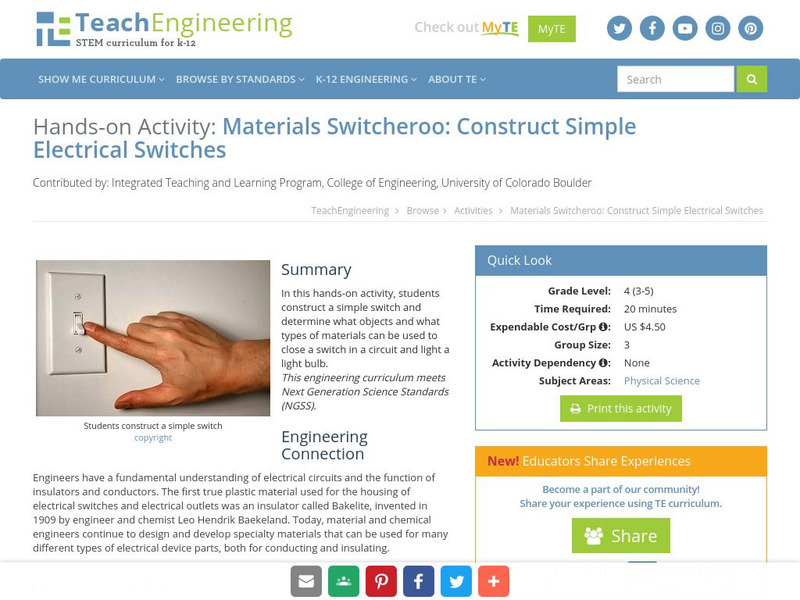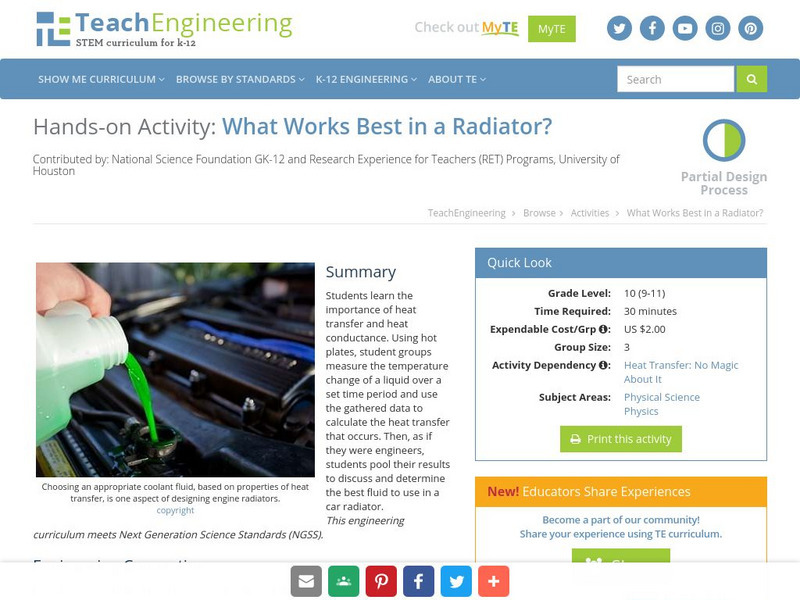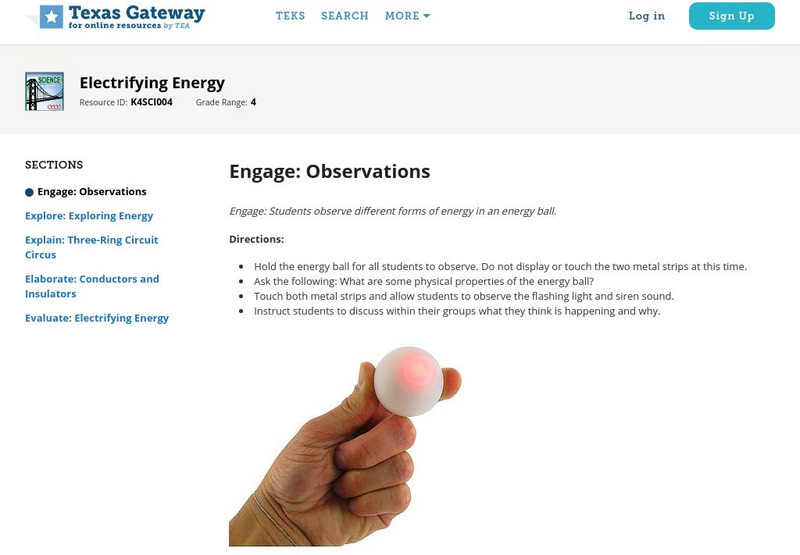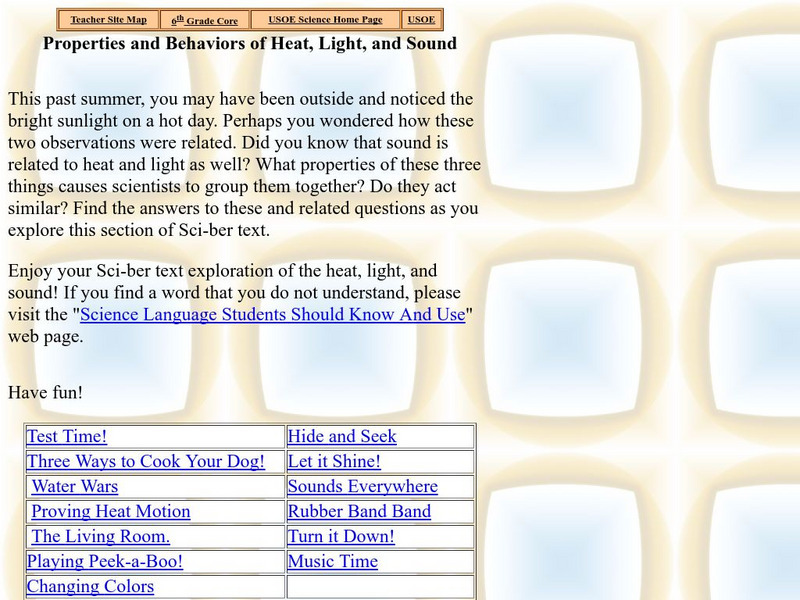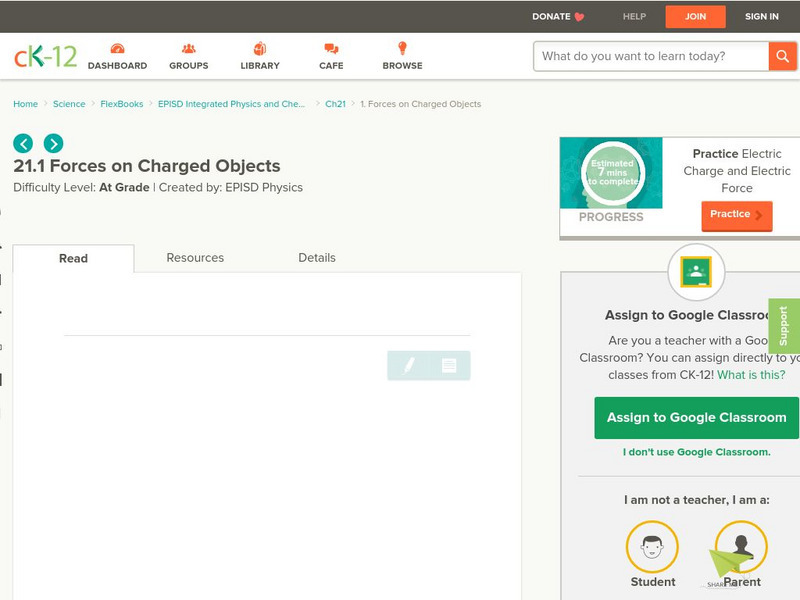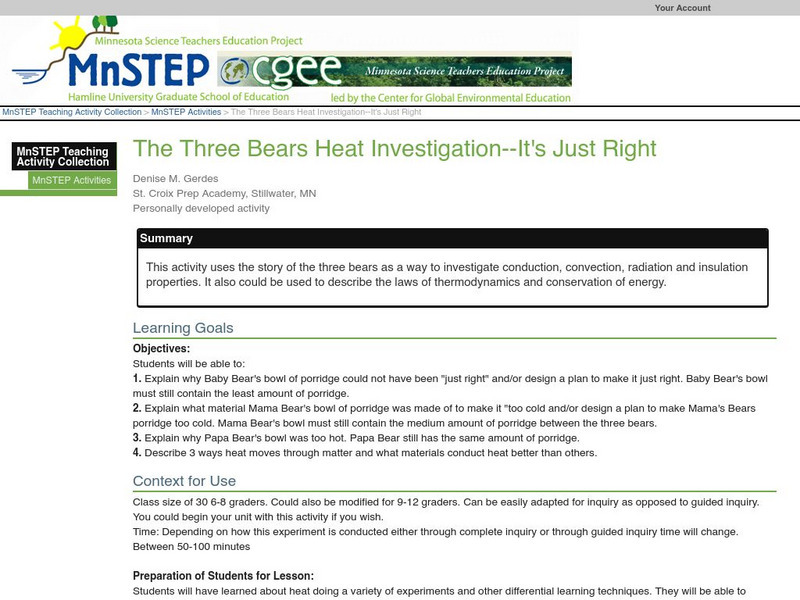Canada Science and Technology Museum
Canada Science and Technology Museum: Background Information for Electricity
The Canada Science and Technology Museum answers some of the most common questions about electricity. For example, get the definition of electricity, the difference between alternating and direct currents, and learn how a fuse works.
OpenStax
Open Stax: College Physics: Conduction
In this section of the textbook, learn about how heat is transferred by conduction. Section explores how to calculate thermal conductivity and studies the thermal conductivities of common substances. Also included are problems with...
TeachEngineering
Teach Engineering: Build a Charge Detector
In this hands-on activity, students explore the electrical force that takes place between two objects. Each student builds an electroscope and uses the device to draw conclusions about objects' charge intensity. Students also determine...
TeachEngineering
Teach Engineering: Will It Conduct?
Students build their own simple conductivity tester and explore whether given solid materials and solutions are good conductors of electricity.
TeachEngineering
Teach Engineering: Switcheroo
In this hands-on activity, students construct a simple switch and determine what objects and what types of materials can be used to close a switch in a circuit and light a light bulb.
TeachEngineering
Teach Engineering: Temperature Tells All!
Students are introduced to the health risks caused by cooking and heating with inefficient cook stoves inside homes, a common practice in rural developing communities. Students simulate the cook stove scenario and use the engineering...
TeachEngineering
Teach Engineering: What Works Best in a Radiator?
Students learn the importance of heat transfer and heat conductance. Using hot plates, student groups measure the temperature change of a liquid over a set time period and use the gathered data to calculate the heat transfer that occurs....
TeachEngineering
Teach Engineering: Conduction, Convection, and Radiation
With the help of simple, teacher-led demonstration activities, students learn the basic concepts of heat transfer by means of conduction, convection, and radiation. Students then apply these concepts as they work in teams to solve two...
TeachEngineering
Teach Engineering: Heat Transfer: No Magic About It
Heat transfer is an important concept that is a part of everyday life yet often misunderstood by students. In this lesson, students learn the scientific concepts of temperature, heat, and the transfer of heat through conduction,...
Texas Education Agency
Texas Gateway: Electrifying Energy
This tutorial reviews over electrical energy.
Exploratorium
Exploratorium: Science Snacks: Physics/electricity & Magnetism
Exploratorium Science Snacks are miniature science exhibits and experiments that can be made with common, inexpensive, easily available materials. These electricity snacks represent a set of devices that you can build and experiment with...
American Chemical Society
Middle School Chemistry: Heat, Temperature, and Conduction
Students observe, describe, and draw a model on the molecular level, showing how energy is transferred from one substance to another through conduction.
Utah State Office of Education
Utah Science: The Mysterious Force
There is a secret mysterious force in your home right this very moment! Try these activities to first identify that force and then extend your knowledge of the force by investigating the other activities provided.
Smithsonian Institution
National Museum of American History: Powering the Past: Emergence of Electrical Utilities in America
Looks at the history of electrical utilities in the United States from the time of Edison up to President Franklin Roosevelt.
OpenSciEd
Open Sci Ed: 6.2 Thermal Energy Teacher Professional Development Overview
This four-day professional development session introduces teachers to the OpenSciEd materials generally in addition to the 6.2 Thermal Energy unit.
Utah State Office of Education
Utah Science: Properties and Behaviors of Heat, Light and Sound
How can scientists lump heat, light and sound together when investigating properties and behaviors? This learning module will address that question through a series of activities.
CK-12 Foundation
Ck 12: Forces on Charged Objects
[Free Registration/Login may be required to access all resource tools.] Students learn which subatomic particles contribute to static electricity, and determine the charge of an object based on what particles it has gained or lost.
BBC
Bbc Schools: Ks2 Bitesize: Science: Physical Processes: Electrical Conductors
Find out which material will save Steve from getting shocked by the electric eels. Following the activity, read more about electrical conductors, and then take a quick quiz to check for understanding.
OpenSciEd
Open Sci Ed: 6.2 Thermal Energy
This Thermal Energy unit has students investigating two ways to transfer energy into a drink: (1) the absorption of light and (2) thermal energy from the warmer air around the drink. They are then challenged to design their own drink...
Concord Consortium
Concord Consortium: Stem Resources: Semiconductors
Several visualizations that help students understand the basic properties of semiconductors. Students can turn a silicon crystal into an insulator or a conductor, investigate the probability waves of an electron, and make a depletion...
Texas Instruments
Texas Instruments: Subnivean Comfort
Students measure and compare air temperatures inside and outside a snow shelter. If students choose to sleep in the shelter overnight they use the temperature measurements to confirm what they discover experientially- that snow is a...
Science Education Resource Center at Carleton College
Serc: Building an Electromagnet
Students will demonstrate how an electric current can make an iron object magnetic by building an electromagnet with a steel nail, insulated wire, a simple switch, a battery/cell, and small metal washers. Students predict the number of...
Science Education Resource Center at Carleton College
Serc: The Three Bears Heat Investigation It's Just Right
This activity uses the story of the three bears as a way to investigate conduction, convection, radiation, and insulation properties. It also could be used to describe the laws of thermodynamics and conservation of energy.
Polk Brothers Foundation Center for Urban Education at DePaul University
De Paul University: Center for Urban Education: Saving Your Family's Energy Dollar [Pdf]
"Saving Your Family's Energy Dollar" is a one page, nonfiction, reading passage about ways to save energy and money by sealing windows and using insulation. It is followed by questions which require students to provide evidence from the...
Other popular searches
- Conductors and Insulators
- Conductors Insulators
- Conductor Insulators
- Thermal Insulators
- Best Insulators
- Science Thermal Insulators
- Heat Insulators
- Water Temperature Insulators
- Conductors Insulators Heat
- Insulators Ice Cube
- Good Insulators
- Conductor and Insulators






